
How to Effortlessly Manage Magento Returns
The Magento returns feature allows customers to request replacements or refunds for items they wish to return. This feature is essential for any e-commerce business as it builds customer trust and provides a hassle-free shopping experience. This tutorial will guide you through setting up the Magento returns feature for your online store.
Key Takeaways
-
Understanding creating Magento returns features to increase customer satisfaction and trust.
-
The returns feature in Magento allows for efficient and easy management of customer refunds or replacements.
-
Proper setup of the Returned Merchandise Authorization (RMA).
-
Delve into steps of managing Magento returns using RMA Extension.
-
With Magento returns, your online store can offer a hassle-free return service to its customers.
Create Magento Returns
When you initiate a return in the Order Management System (OMS) Admin under Customer Service > Orders, the magento.postsales.return_management.authorize operation is triggered.
The order lines must be in a SHIPPED status to create a return. Let's have a look at an example of a magento.postsales.return_management.authorize message:
{
"return": {
"sales_channel_id": "ST1",
"order_id": "000000255",
"source_id": "SOU1",
"user": "userA",
"custom_attributes": [],
"lines": [
{
"id": "98",
"line_number": 1,
"custom_attributes": [],
"reason": "Wrong",
"reason_description": "I dont like"
}
]
}
}
What is Returned Merchandise Authorization (RMA)
An RMA (Returned Merchandise Authorization) is provided to customers who wish to return an item for a refund or replacement. Customers typically contact the merchant to start the return process. Once approved, a specific RMA number is assigned to identify the returned product.
Within the configuration settings, there are two options available for managing returned merchandise requests (RMAs). You can either enable RMA for all products or restrict it to specific products. The Returns grid displays existing RMAs and serves as a platform to submit new return requests.

RMAs can be requested for various product types, including simple, configurable, grouped, and bundle products. However, please note that downloadable products, virtual products, and gift cards are not eligible for RMAs.
RMA and return workflow
- Receive request: If the option is activated for the online store, both registered customers and guests have the ability to request an RMA. Additionally, you can also initiate an RMA request from the administrative side.
- RMA issued: Once you have reviewed the request, you have the option to partially authorize it, fully authorize it, or cancel the request altogether. If you choose to authorize the return and agree to cover the return shipping costs, you can generate a shipment order through Magento Admin using a supported carrier.
- Merchandise received and product return processed: Here's a flow chart that outlines the steps to follow in order to complete the return process:
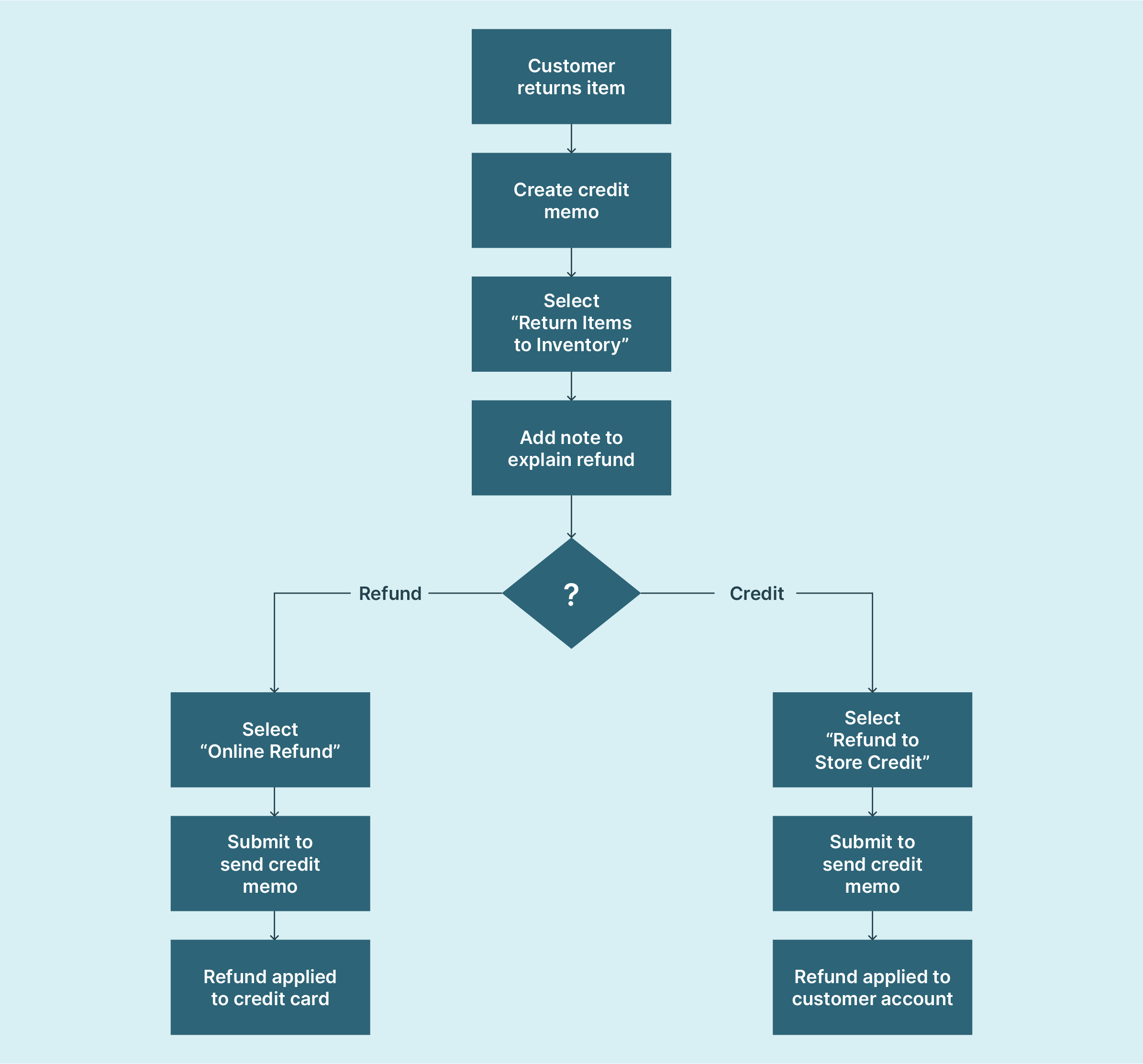
Create a Return Request in the Admin
From the Admin, a merchant has the ability to initiate a return request on behalf of a customer. Customers can create return requests directly on the storefront for an Adobe Commerce store. Then admins need to follow these steps:
-
Access the "Returns" section by navigating to the "Sales" tab on the "Admin" sidebar.
-
Click on New Return Request.
-
Select an order marked as "Complete" to initiate a return request.
-
In the "Return Information" section, click on the "Return Items" tab.
-
To include items for return, select the "Add Items" option.
-
To add the desired product to your returns, check the checkbox next to it and click the "Add Selected Product to returns" button.
-
Enter the number of items to be returned.
-
In the "Requested" field, input the quantity of items you want to return.
-
Wrong Color
-
Wrong Size
-
Out of Service
-
Other
Please select a return reason from the provided list. You can specify your reason when choosing the "Other" option if your reason is not listed.
- Please select the Item condition for the item from the following options:
-
Unopened
-
Opened
-
Damaged
- Choose one of the following options for the Resolution:
-
Exchange
-
Refund
-
Store Credit
- To initiate a return, click the "Submit Returns" button.
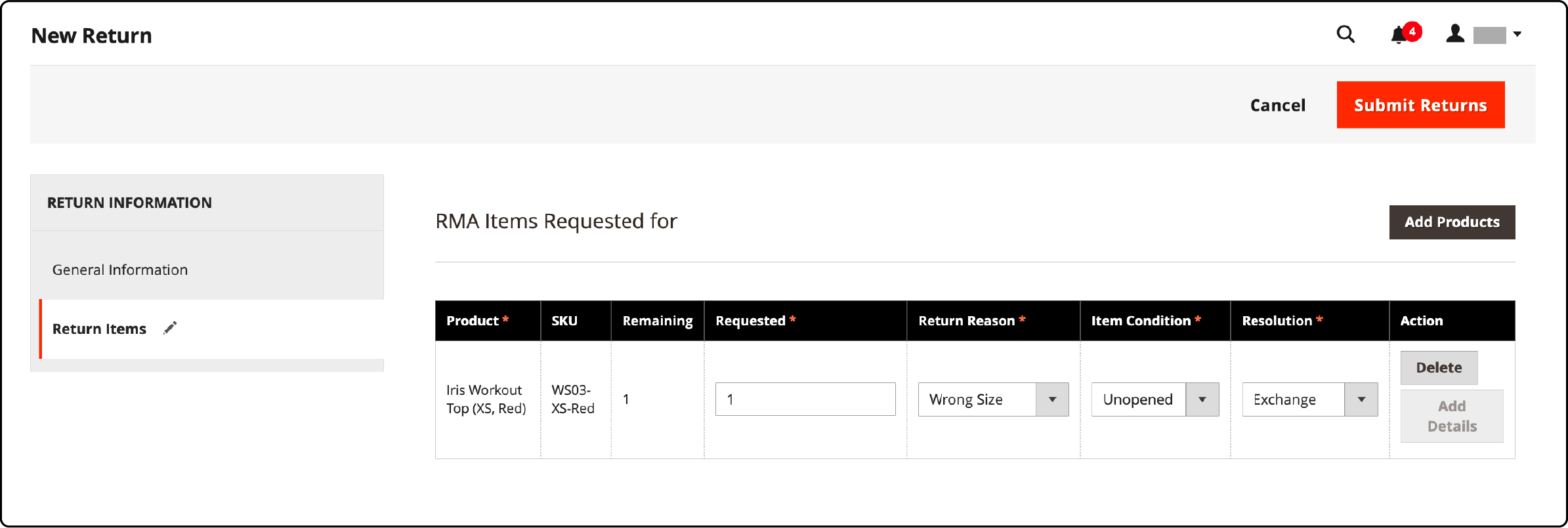
The recently submitted RMA request can be found on the Returns page, indicated as "Pending" in status.
5 Steps to Manage Magento Returns Using RMA Extension
To effectively handle customer order returns in your Magento 2 store, the initial step is to acquire the Magento 2 RMA Extension. After acquiring and setting up the RMA extension, it is crucial to configure it within your Magento 2 store properly.
Once the RMA extension is successfully configured, you can proceed with the following steps to effectively handle customer order returns in your Magento 2 store:
- Log in to your admin panel and go to Stores > RMA > RMA List.
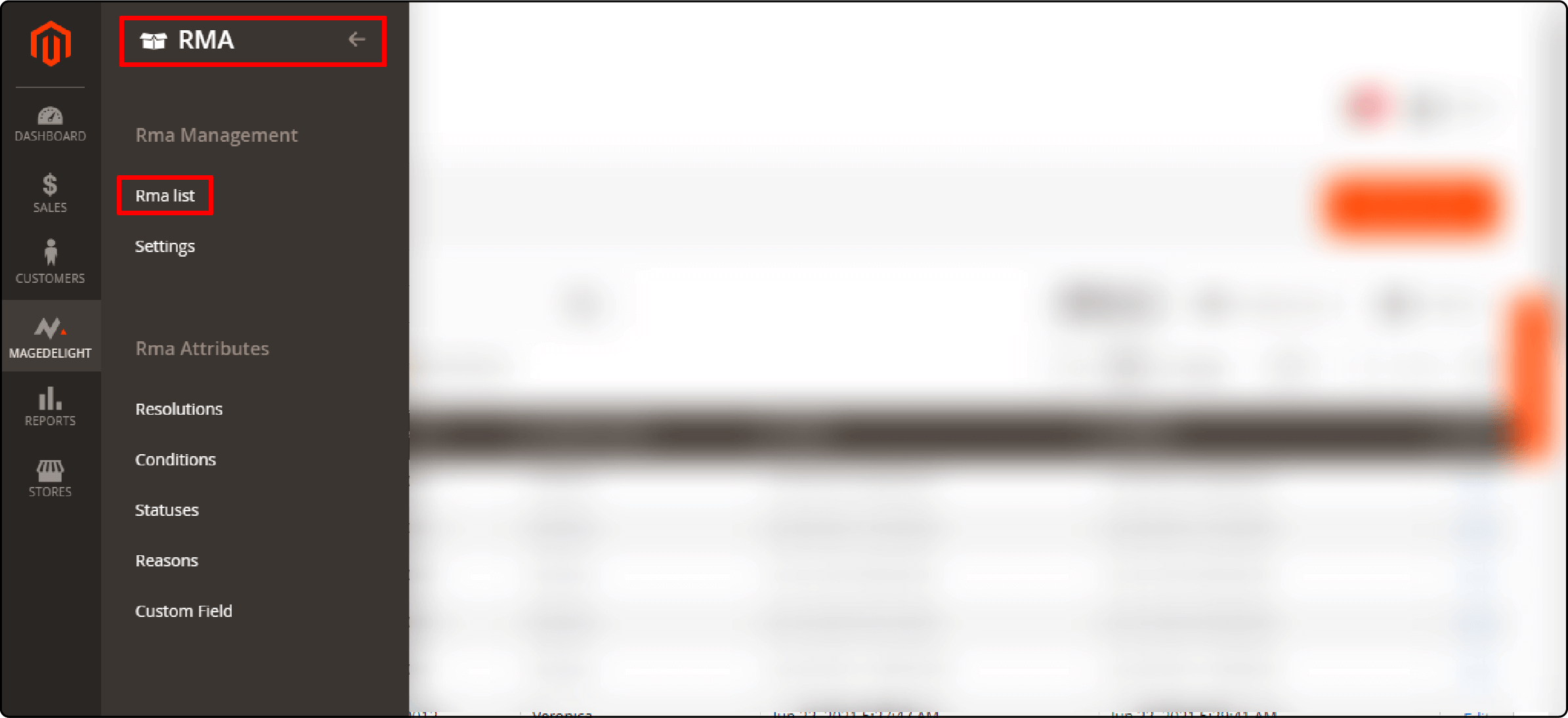
You'll find all customer-generated order return requests after configuring the RMA extension.
- To handle return orders, use the RMA list. Click on the Edit button of any return request as indicated below:
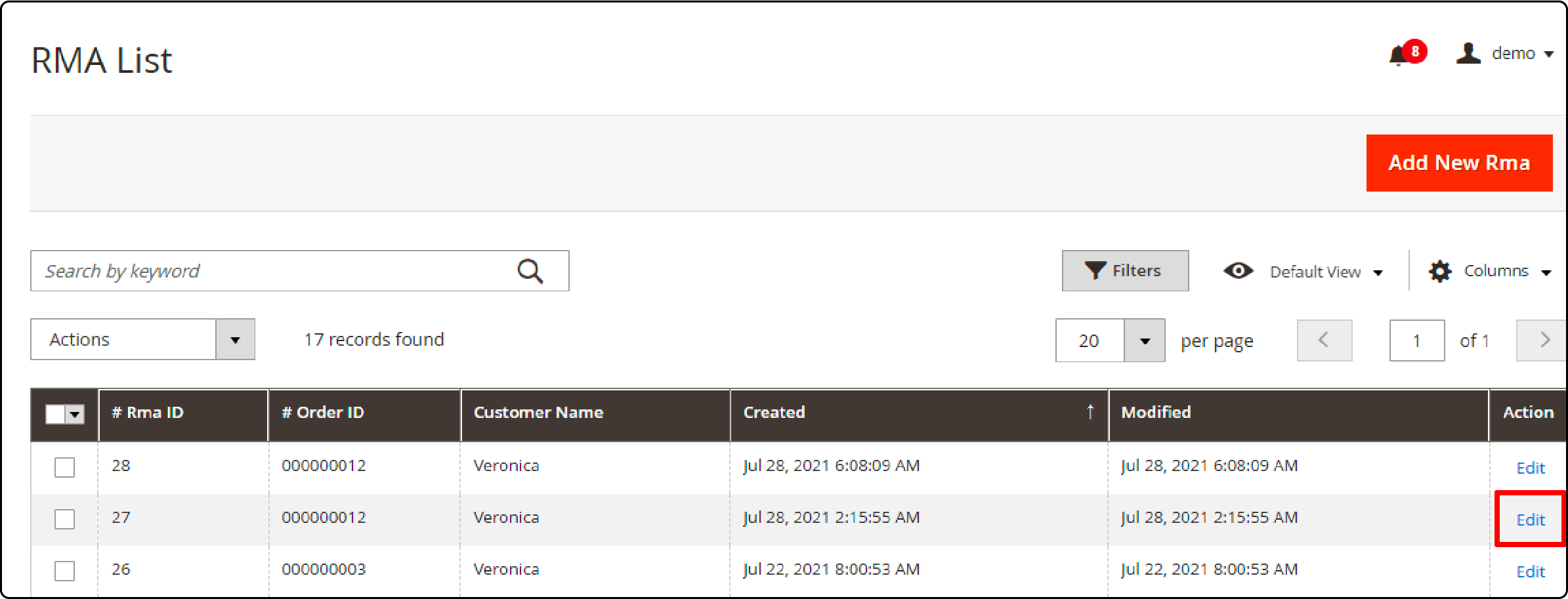
- When you click on the edit button, a screen will appear, resembling the screenshot below:
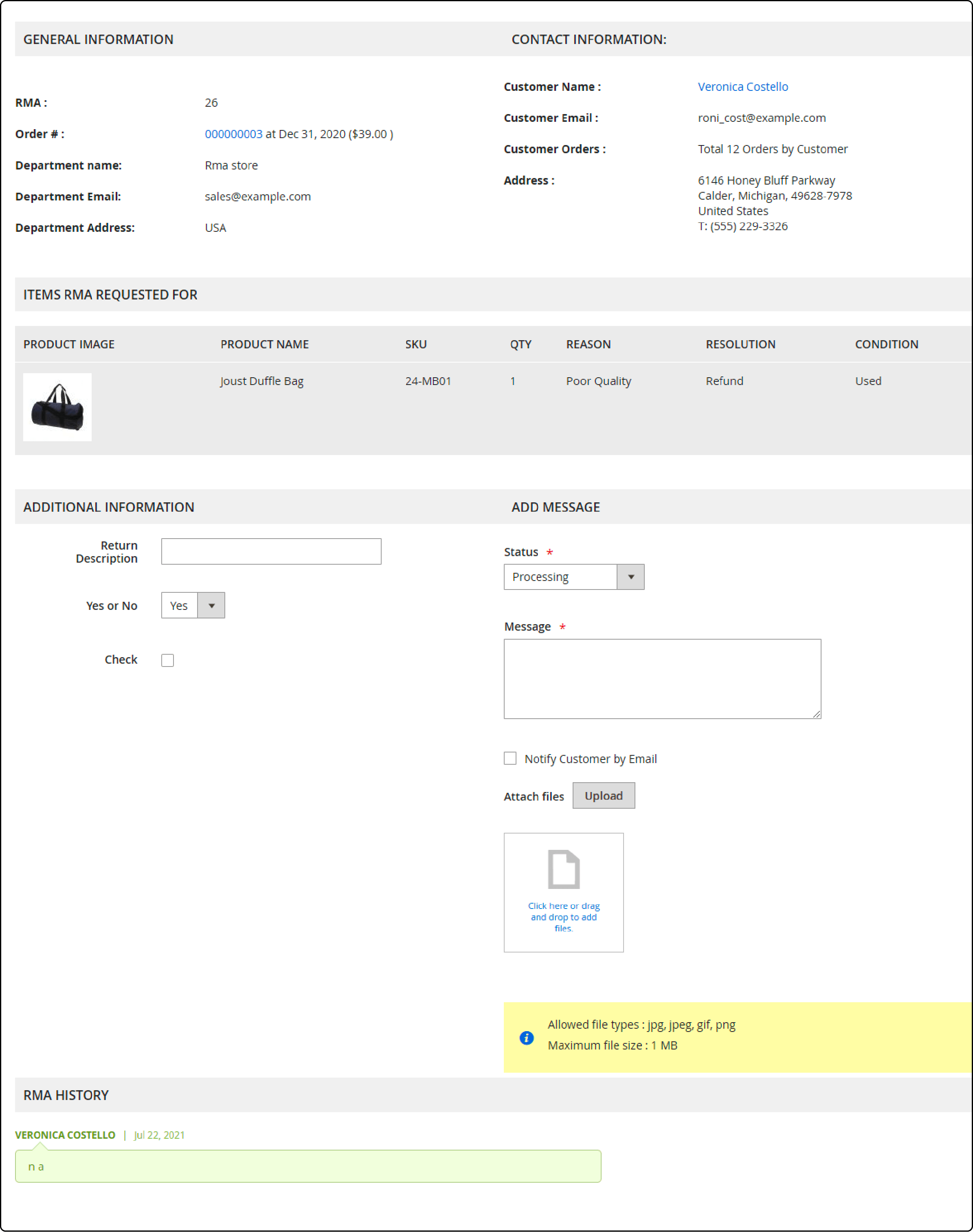
- To approve the customer order return request, go to the Status dropdown field and choose "A Valider". Scroll down and make the selection.

- You can complete the process by selecting the Save button in the top-right corner.

The RMA extension provides an update at each stage, keeping the shopper and the store owner on the same page. It allows the buyer to attach files, pictures, and messages, providing a comprehensive view of the problem. This strategy enables merchants to take informed actions, keeping in mind the package condition and the place of purchase.
Benefits of Managing Magento Returns
Managing Magento returns effectively offers an opportunity for both merchants and clients to ensure a smooth shopping experience. When a buyer raises an issue, the merchant's team can review the case, depending on the country and the type of purchase made. The Magento version and the type of extensions play a critical role in this process.
This process is attributed to positive customer reviews, which are a powerful marketing tool. Thus, handling Magento returns isn't just a necessary task but an opportunity to enhance client relationships and improve business reputation. Some key upsides of managing Magento returns are:
1. Packaging Receipt and Label Management
Through Magento's Return Management Authorization (RMA) Extension, sellers can effectively manage the packaging receipt and label for every return. The ability to track the return from the time it is shipped until it reaches the warehouse enables efficient logistics and reduces the risk of lost items.
2. Restocking Fee and Defective Item Handling
Magento Returns provides a feature to apply a restocking fee for returnable items. It can be set as a specified percentage of the item's original amount. For defective products, there's a different process. The system allows customers to report defects via a form and can automatically exempt defective items from restocking fees.
3. Differentiating Returnable and Non-Returnable Items
Magento's RMA module assists in clearly identifying returnable and non-returnable items. Sellers can include this information in the item's name or description. This clear differentiation avoids confusion and unnecessary returns, leading to customer satisfaction and effective account management.
4. Comprehensive Return Policy
Magento Returns provides a comprehensive solution to manage return policies. It allows sellers to set a return period for each item, and the return policy details can be included under each product's description. For some specific purchases, sellers can add comments or additional terms to their return policies.
5. Efficient Generation of Shipping Labels and Return Forms
The RMA extension provides a feature for the automatic generation of shipping labels and return forms, which customers can print from their account. This way, customers are guided at every step of the return process, offering an easy and hassle-free return solution. The forms also provide space for reasons for return, which gives valuable insights into product improvement.
FAQs
1. What features does Magento Returns offer to assist in handling returns?
It offers a host of features to assist businesses in handling returns. These include identifying returnable and non-returnable items, setting up return policies, generating shipping labels, and return forms efficiently. The system also provides notifications on status updates and changes, thus keeping both the company and shoppers informed.
2. How does the Magento Returns tool support customer loyalty?
Automatic generation of shipping labels and return forms, a clear delineation between returnable and non-returnable items, and timely notifications contribute to a better customer experience. It also allows for exchanges, upholding customer's value and trust in the brand. By making returns hassle-free, it optimizes customer loyalty.
3. What are the benefits of using Magento Returns for businesses?
It helps businesses streamline the return process, control return rules, and manage return-related data effectively. With dedicated support and a user-friendly interface of Magento hosting, it reduces workload and provides valuable insights for strategic decision-making.
4. How does the Magento Returns extension handle return shipping?
It supports multiple shipping carriers like UPS, DHL, and FedEx, enabling businesses to offer flexible return shipping options to customers. The extension automatically generates and updates shipping labels, ensuring an efficient return process.
5. How can Magento Returns contribute to improving a company's services?
Businesses can meet customer expectations and boost their satisfaction by offering a streamlined return process. Additionally, the system helps gather valuable feedback and ecommerce analytics, allowing businesses to improve their offerings and build long-term customer relationships.
6. How does Magento Returns assist store owners in handling issues related to returns and exchanges?
Magento Returns offers robust tools and resources to assist store owners in managing return-related issues. With a comprehensive assistance menu, owners can easily navigate through various features and functions of the extension.
It provides easy access to return statuses, handling different types of returns such as SKU or category-based returns, and even dealing with specific return cases. Furthermore, the system links helpful templates for return instructions and emails, ensuring a comprehensive approach to solving return-related problems.
7. How can businesses save money and resources by using Magento Returns?
Magento Returns provides businesses with a cost-effective solution for managing returns and exchanges. Its user-friendly interface and powerful features reduce the time and resources spent processing returns.
With automatic updates of return statuses, e-commerce businesses can streamline their return handling process, saving both money and resources. The extension also allows store owners to set up custom email templates and image fields, ensuring personalized customer communication.
8. What role does technology play in the delivery of Magento Returns services?
Technology is at the heart of Magento Returns' services. The system employs extension technology to provide a seamless return experience. It supports multiple shipping carriers, automatically generates shipping labels, and updates real-time return statuses.
The extension also provides an easy setup link for Google services, enhancing visibility and traffic for the e-commerce store. Moreover, technology enables customization of return reasons and categories, offering flexibility to businesses in managing their return processes.
Summary
Managing Magento returns streamlines the return handling process for ecommerce stores. With its customizable options, automated processes, and detailed insights, you can easily manage product returns, exchanges, and refunds.
Opting for managed Magento hosting can boost Magento returns' efficiency with robust infrastructure, superior performance, and 24/7 support for seamless ecommerce operations.


